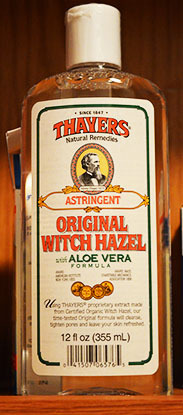Witch Hazel : Modern Medicinal Uses

A modern formula of witch hazel
extract, combined with aloe vera
(Hayes, 2014).
Witch hazel extract is an old medicine that outlived many early patent medicines, and many of its applications have stayed the same. It is one of few plants that are approved by the Food and Drug Administration and is recommended for the treatment of sores, minor lacerations, sprains, and tired eyes. Witch hazel’s healing properties come from its tannins, which act as anti inflammatories and astringents. Upon contact to the body, witch hazel extract causes the coagulation of surface proteins which inhibits permeability and secretions.
The extract is shown to work just as well on skin inflammation as 1% hydrocortisone and has “significant antiviral activity against herpes simplex virus type 1” (Jamison, 2003, p. 749). Witch hazel leaves contain 7-10% tannins and also essential oils that are responsible for the tree’s strong smell, and flavonoids which create a brown pigment in traditional witch hazel extract. Including ailments noted by the FDA, witch hazel may also be used to treat burns, colds, fever, itching, and hemorrhoids.
Witch hazel is a common ingredient in many modern herbalism remedies. Rosemary Gladstar, the “godmother of American herbalism”, includes over 15 recipes and remedies using witch hazel in Rosemary Gladstar's Herbal Recipes for Vibrant Health. Combined with tea tree oil, witch hazel extract can be used as a wound wash or added to shampoo to relieve oily hair. Internally, it is noted for its abilities to stop diarrhea and even intestinal bleeding. She also includes an anti itch remedy, which combines witch hazel extract, volcanic clay, salt, and peppermint essential oil. Witch hazel’s use as a medicinal is important because it is present in both alternative practice and allopathic medicine. Its recognition in the herbal world and by the FDA speak to the effectiveness of its multipotent qualities.
